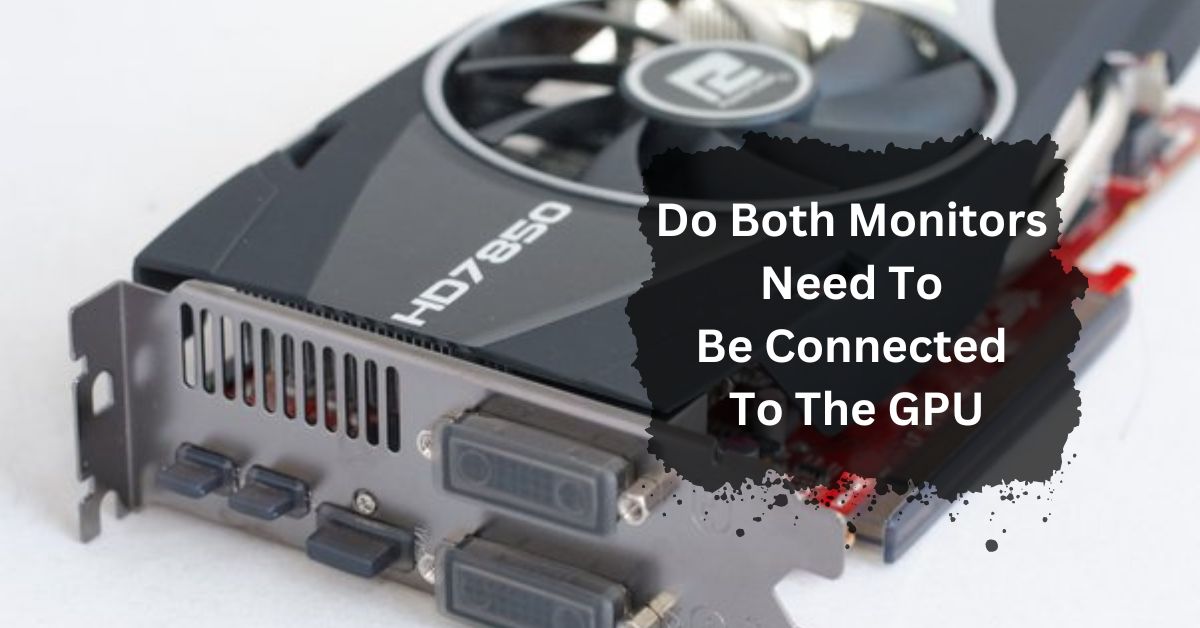Dual monitor setups are becoming increasingly popular for both work and play. Whether you’re a gamer, a professional, or just someone who enjoys the extra screen real estate, having two monitors can significantly enhance your experience.
Yes, for the best performance, both monitors should be connected to the GPU. This ensures that the GPU handles all display tasks. Connecting to the motherboard might use integrated graphics, reducing performance for demanding tasks.
In this article, we will discuss “Do Both Monitors Need To Be Connected To The GPU”.
Table of Contents
Understanding GPU:
What is a GPU?
A GPU, or Graphics Processing Unit, is a specialized processor designed to handle the complex calculations required for rendering images and videos.
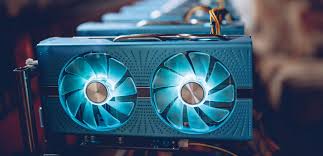
Unlike a CPU, which handles general computing tasks, a GPU is optimized for parallel processing, making it essential for tasks that require high-performance graphics.
Functions of a GPU:
GPUs are responsible for rendering everything you see on your screen, from the desktop interface to high-end video games. They offload the graphics processing tasks from the CPU, allowing for smoother performance and better visuals.
Dual Monitor Setups:
Benefits of Dual Monitors:
Having two monitors can increase productivity by allowing you to multitask more efficiently. You can have one monitor dedicated to your main task, while the other displays reference materials, emails, or other applications.
Common Uses of Dual Monitors:
Dual monitors are commonly used by professionals who need multiple applications open simultaneously, gamers who want an immersive experience, and content creators who require a larger workspace.
Connecting Monitors to the GPU:
Why Connect Monitors to the GPU?
Connecting your monitors to the GPU ensures that you get the best possible performance and image quality. The GPU is designed to handle high-resolution displays and multiple outputs, making it the ideal choice for dual monitor setups.
GPU Ports and Compatibility:
Most modern GPUs come with multiple output ports, such as HDMI, DisplayPort, and DVI, allowing you to connect more than one monitor. It’s essential to check your GPU’s specifications to ensure compatibility with your monitors.
Alternative Connection Methods:
Integrated Graphics:
Many CPUs come with integrated graphics, which can handle basic tasks and support multiple monitors. However, integrated graphics typically lack the power needed for high-performance tasks, such as gaming or professional video editing.
USB to HDMI Adapters:
USB to HDMI adapters offer another way to connect additional monitors. While convenient, these adapters often don’t provide the same performance and image quality as a direct GPU connection.
Performance Considerations:
GPU Performance with Dual Monitors:
Using a GPU to drive two monitors can slightly impact performance, especially in resource-intensive applications. However, modern GPUs are designed to handle multiple displays with minimal performance loss.
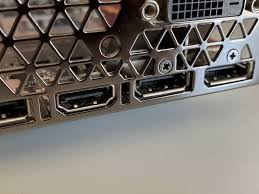
Impact on Integrated Graphics:
Relying on integrated graphics for dual monitors can lead to significant performance drops, especially if you’re running demanding applications. For the best experience, it’s advisable to use a dedicated GPU.
Gaming and Professional Use:
Gamers’ Perspective:
For gamers, connecting both monitors to the GPU is crucial. It ensures that games run smoothly and look their best, without putting unnecessary strain on the system.
Professionals’ Perspective:
Professionals, such as graphic designers and video editors, also benefit from connecting both monitors to the GPU. It allows for better color accuracy, faster rendering times, and a more responsive system.
Potential Issues and Troubleshooting:
Common Connection Problems:
Some common issues include monitors not being detected, incorrect resolutions, and display flickering. These problems can often be resolved by updating drivers, checking cable connections, and configuring display settings correctly.
Solutions and Tips:
Ensure that your GPU drivers are up to date, use high-quality cables, and double-check your monitor settings. If problems persist, consulting the GPU manufacturer’s support can be helpful.
Choosing the Right GPU:
Factors to Consider:
When choosing a GPU for a dual monitor setup, consider factors such as the number of available ports, performance capabilities, and compatibility with your monitors.
Popular GPUs for Dual Monitor Setups:
Popular options include the NVIDIA GeForce RTX series and the AMD Radeon RX series, both known for their excellent performance and multiple output options.
Read: Is Minecraft CPU Or GPU Intensive – Complete Guide – 2024!
Setting Up Dual Monitors:
Step-by-Step Guide:
- Connect each monitor to the GPU using the appropriate cables.
- Power on the monitors and the computer.
- Access the display settings in your operating system.
- Arrange the monitors as desired and set the primary display.
- Adjust the resolution and scaling settings for optimal performance.
Configuring Display Settings:
In the display settings, you can configure how the monitors are arranged, set the primary monitor, and adjust the resolution and scaling. This ensures that both monitors provide the best possible experience.
Optimizing Performance:
Software Tools:
Software tools like NVIDIA Control Panel or AMD Radeon Settings can help you fine-tune the performance and appearance of your dual monitor setup.
Hardware Upgrades:
Upgrading your GPU or adding more RAM can further enhance the performance of your dual monitor setup, especially if you’re running demanding applications.
Read: Is 12GB GPU Enough For Gaming – A Ultimate Guide of 2024!
Cost and Budget Considerations:
Budget-Friendly Options:
For those on a budget, entry-level GPUs like the NVIDIA GTX 1650 or AMD RX 550 offer decent performance for dual monitor setups.
High-End Solutions:
High-end GPUs, such as the NVIDIA RTX 3080 or AMD RX 6800 XT, provide top-tier performance and can handle multiple high-resolution monitors with ease.
How to Set Up Dual Monitors with GPU and Motherboard?
To set up dual monitors with a GPU and motherboard, connect one monitor to the GPU and the other to the motherboard. Enable integrated graphics in BIOS settings, then adjust display settings in your operating system to configure both screens.
Can one GPU run two monitors?
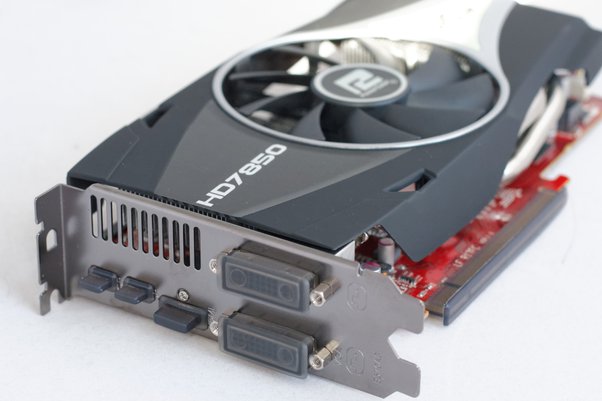
Yes, one GPU can run two monitors. Most modern GPUs have multiple ports (HDMI, DisplayPort, etc.) to support dual monitors. Just connect both monitors to the GPU, then adjust the display settings in your operating system.
Read: Is Rust CPU Or GPU Heavy – A Complete Guide Of 2024!
Do you need two monitors for GPU passthrough?
No, you do not need two monitors for GPU passthrough. One monitor can be used, but having two monitors can make the setup easier by allowing you to manage both the host and the virtual machine simultaneously.
Read: What Is A Good GPU Temperature – Complete Guide – 2024!
How to set up dual or multiple monitors?
To set up dual or multiple monitors, connect each monitor to your GPU using the appropriate cables (HDMI, DisplayPort). Then, adjust your display settings in your operating system to configure the arrangement and resolution of the monitors.
Read: What Is Idle GPU Temperature – A Complete Guide Of 2024!
Can I use 2 monitors on my PC without graphics card?
Yes, you can use two monitors on your PC without a graphics card if your motherboard has multiple display ports. Connect each monitor to the motherboard ports, then adjust your display settings in your operating system.
Read: Is 70 GPU Temp Bad – A Ultimate Guide Of 2024!
Do both monitors need to be connected to the gpu windows?
For the best performance on Windows, both monitors should be connected to the GPU. This ensures the GPU handles all display tasks efficiently. Connecting to the motherboard might use integrated graphics, which can reduce performance.
Should I connect my second monitor to GPU or motherboard?
Connect your second monitor to the GPU for the best performance. This allows the GPU to handle all display tasks. Connecting it to the motherboard may use integrated graphics, which can lower performance, especially for demanding applications.
Can I have one monitor on GPU and other to motherboard?
Yes, you can have one monitor connected to the GPU and the other to the motherboard. However, using both monitors with the GPU is usually better for performance. Check your system settings to manage displays effectively.
One monitor in GPU one in motherboard?
Yes, you can connect one monitor to the GPU and one to the motherboard. This setup is possible but may not offer the best performance. Connecting both monitors to the GPU is usually better for smoother graphics and better performance.
How to connect two monitors to GPU?
To connect two monitors to your GPU, plug each monitor into a separate port on the GPU using the appropriate cables (HDMI, DisplayPort). Then, adjust the display settings in your operating system to configure and arrange the monitors.
Should I plug both monitors into graphics card or only one?
You should plug both monitors into the graphics card. This ensures the GPU handles all display tasks, providing better performance and smoother graphics. Connecting both monitors to the GPU is usually better than using one monitor on the motherboard.
Should I connect HDMI to motherboard or graphics card?
You should connect HDMI to the graphics card for better performance. The GPU handles more demanding tasks, giving you smoother graphics. Connecting HDMI to the motherboard may use integrated graphics, which can be less powerful.
Should the monitor be connected to the GPU?
Yes, the monitor should be connected to the GPU for the best performance. The GPU provides better graphics and handles more demanding tasks compared to integrated graphics from the motherboard. This setup ensures smoother and more efficient display performance.
How to connect the monitor with a Graphics card?
To connect a monitor to a graphics card, plug the monitor cable into the correct port on the graphics card. Use HDMI, DisplayPort, DVI, or VGA, depending on the ports available on both the monitor and graphics card.
Does plugging your monitor to the GPU improve gaming?
Yes, plugging your monitor into the GPU improves gaming. The GPU is designed to handle graphics, giving better performance and visuals. Using the motherboard’s port can limit your gaming experience and reduce overall quality.
Is it okay to plug the monitor into the motherboard?
Yes, it’s okay to plug the monitor into the motherboard, but it’s best for simple tasks like web browsing. For gaming or graphic-heavy work, plug the monitor into the GPU for better performance and visuals.
Can I plug my second monitor into my motherboard?
Yes, you can plug your second monitor into the motherboard, but it’s better to use the GPU for both monitors if possible. This ensures better performance, especially for gaming or using graphics-intensive applications.
How to connect two monitors to one PC with HDMI?
To connect two monitors to one PC with HDMI, plug one monitor into the HDMI port on the GPU. For the second monitor, use another HDMI port on the GPU or an HDMI splitter if only one port is available.
GPU only has one HDMI?
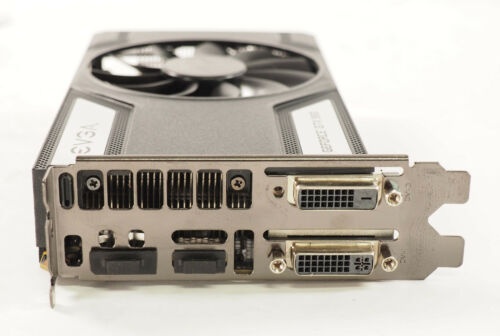
If your GPU only has one HDMI port, use a different port like DisplayPort or DVI for the second monitor. You can also use an HDMI splitter or an adapter to connect both monitors.
FAQs:
1. Can I connect one monitor to the GPU and one to integrated graphics?
Yes, but this can lead to performance issues and is generally not recommended for demanding tasks.
2. Do I need a special GPU for dual monitors?
Most modern GPUs support dual monitors. Check the specifications to ensure compatibility.
3. How do I fix flickering on my second monitor?
Ensure your cables are secure, update your GPU drivers, and check your display settings.
4. Can I use a USB to HDMI adapter for my second monitor?
Yes, but it may not provide the same performance and image quality as a direct GPU connection.
5. What are the best GPUs for dual monitor setups?
Popular options include the NVIDIA GeForce RTX series and the AMD Radeon RX series for their excellent performance and multiple output options.
Conclusion:
In conclusion, for the best performance, connect both monitors to the GPU. This ensures smoother graphics and better performance for tasks like gaming and professional work. While you can use integrated graphics or USB adapters, they won’t offer the same quality. Always check your GPU’s ports and compatibility for the best setup.
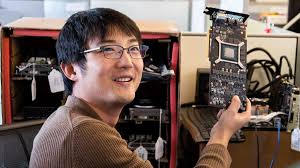
I’m Noah Lucas, the voice behind the content you find here. With 5 years of experience in the GPU field, my goal is to provide clear and helpful information to everyone interested in this technology.
Whether you’re new to GPUs or looking to deepen your understanding, my articles aim to break down complex topics into simple, easy-to-understand language. This way, no matter where you’re from, you can find the information you need without any confusion.

